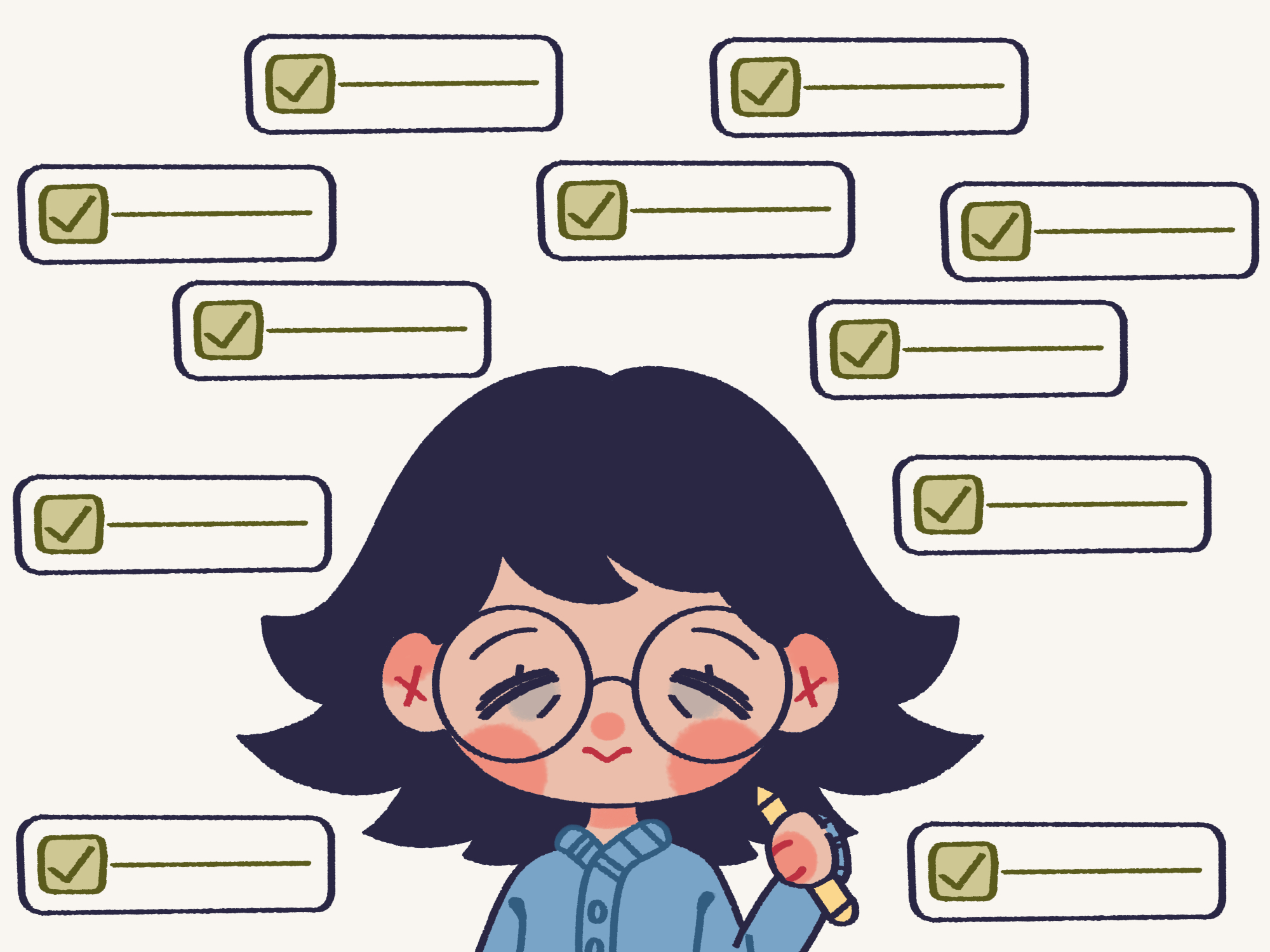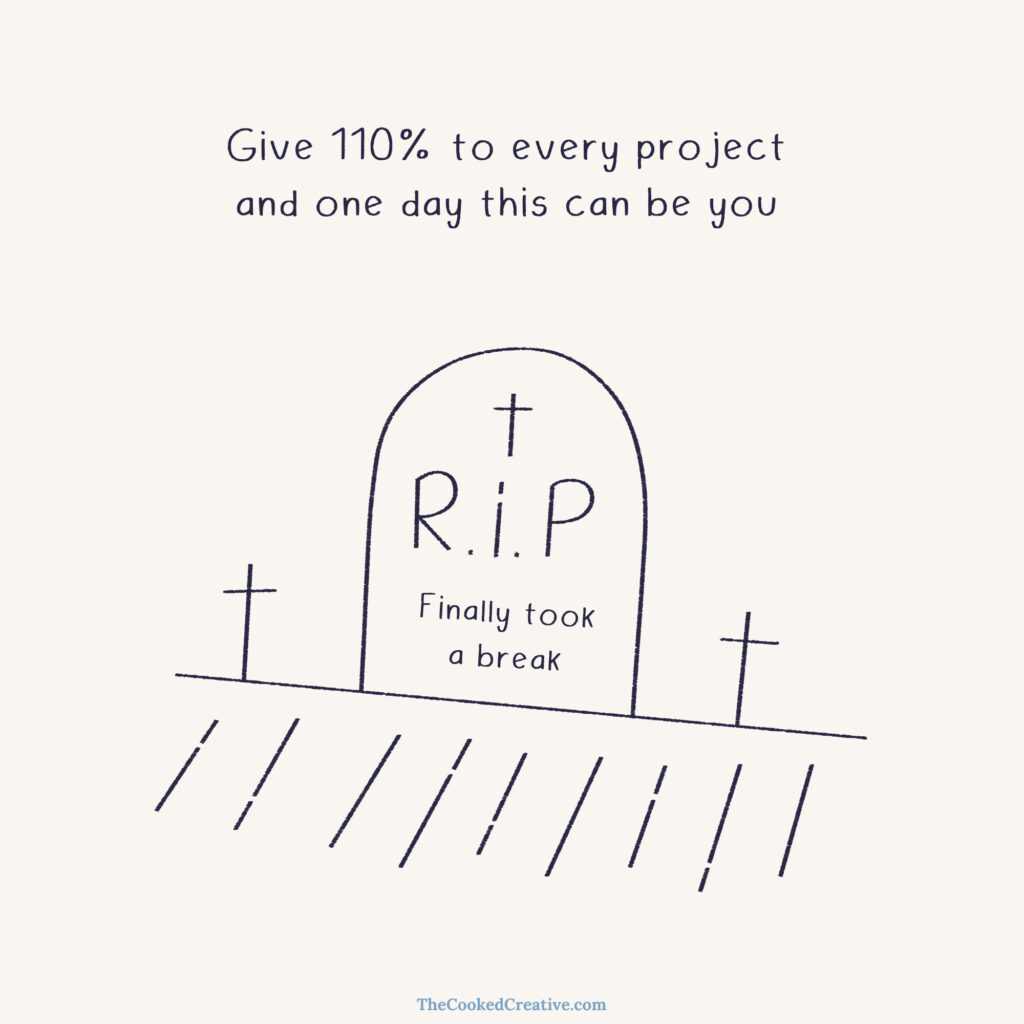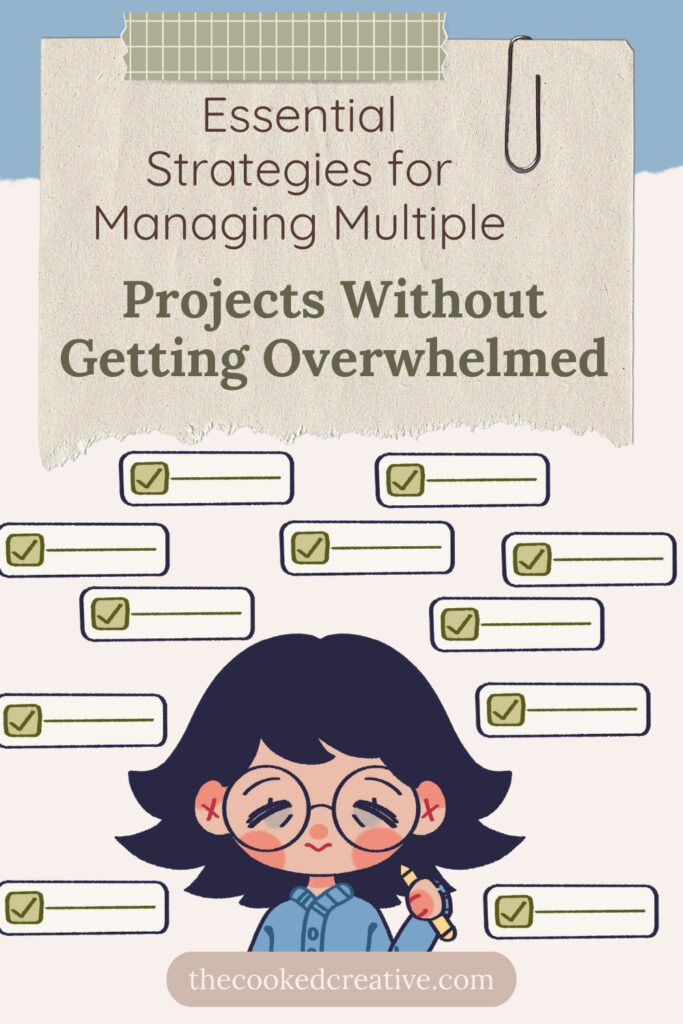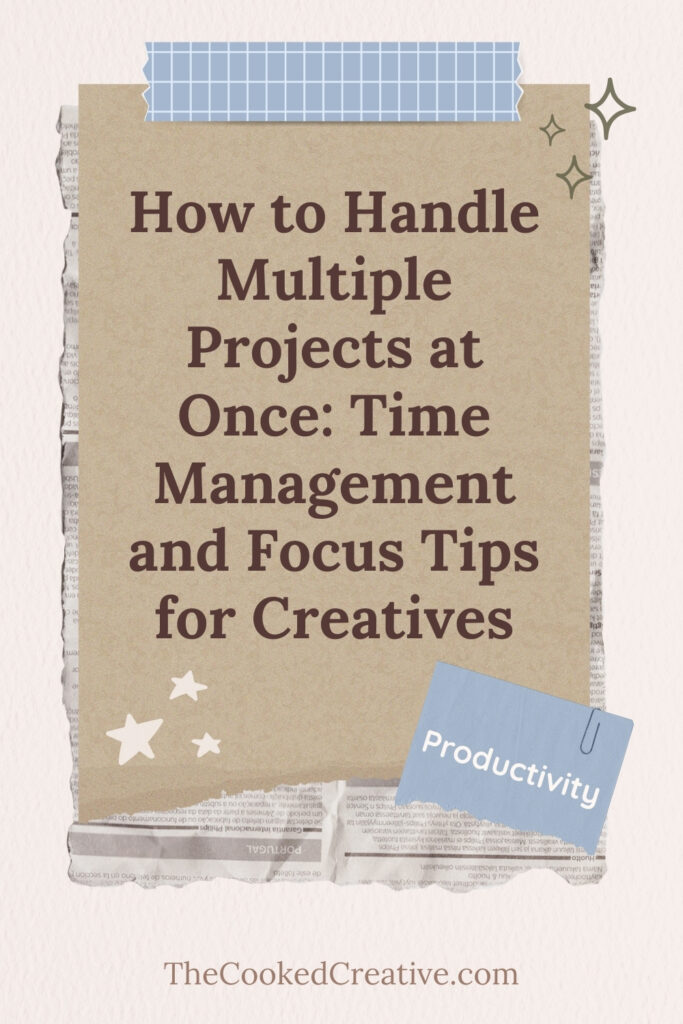
Essential Strategies for Managing Multiple Projects Without Getting Overwhelmed
TCC is reader-supported. This post contains affiliate links to products I have used and loved. If you click and make a purchase, I may receive a small commission at no extra cost to you. Thank you!
Does anyone else feel the need to start a new project every other week? As creative people, we tend to be brimming with new ideas to explore and ways to express ourselves, but sometimes the ideas become too many, or too big, and it gets overwhelming to deal with. If you create projects with friends, or projects for work, there are other people in the mix to take into consideration, and good planning and solid systems can make or break your project.
A glance at my calendar and I see deadlines piling up, priorities shifting, and it’s so easy to fall into a game of infinite catching up. In this blog post, I aim to give you tools to be more efficient and share some tips and tricks to keep the right approach so you stay organized and focused without the overwhelm or burnout. You don’t have to sacrifice your well-being!
5 principles to effective project managing
Trust me when I say that you need more than a long to-do list to manage your projects, I have tried! You need a solid foundation built on easy, simple planning and adaptable systems. Even if you are planning a tiny personal project just for fun, a little bit of planning goes a long way! And let’s not even start with bigger, team projects.
Clear planning: Start each project with clarity. Make sure you define the scope of what needs to be done, set realistic goals, and clarify who is doing what if you’re collaborating with other people.
Prioritization and delegation: Not all tasks are equally important. Make sure you identify what’s urgent, what’s important, and what could be delegated to other people if necessary. More on this below!
Flexibility: Planning is important, but so is the ability to pivot and adjust as time goes on. Unexpected problems happen and priorities shift all the time. Flexibility helps you maintain momentum without falling apart when the plan doesn’t go as expected.
Risk management: Every project comes with its obstacles. Maybe you miscalculated the scope, are facing burnout or art block, or missed some deadlines. If you can identify the risks or obstacles of your project early, you can prepare for them. That might mean building in some buffer time, having a backup plan for tech issues, or scheduling some personal downtime.
Regular reviews: Set a time weekly to check your progress across your projects. Are you on track? What are your priorities? Use a short moment to make small adjustments before the problems become bigger.
Planning and organizing
When you’re managing multiple projects, handling all the moving parts can become difficult. Here are some tips to help you organize better and minimize stress.
Step-by-step process
- Set specific goals and timelines for each project. Have deadlines for small milestones and a clear finish line.
- Brain dump to get all your tasks out on paper and laid out for you to categorize. Then pick a prioritization method. There are plenty to choose from, such as the MoSCoW method, the Eisenhower matrix, or a simple task hierarchy that can help you focus on the right things at the right time. Break bigger tasks into smaller actionable steps, this will ensure you are making steady progress even on busy days!
- Adjust your schedule as needed. Not all your projects have to move at the same pace. Spread your tasks and energy wisely across your calendar and find your rhythm. Maybe some projects need work daily, others once or twice a week, or even a couple of times a month. Overlapping all your projects on the same day is one sure way to burn out! Use visual tools like a calendar or a Gantt chart to help you see all your projects together and make sure you’re not over-saturating your days or stacking overlapping deadlines. Balance is key.
- Update regularly. Projects evolve, so make sure you check in periodically to make the adjustments necessary.
Time and focus management
Okay, your projects are all planned out and the framework is decided! Now all you have to do is manage your time and focus on your tasks. Easier said than done. Here are some simple tips to help you stay on top of your tasks while preventing the hustle, always-working, overwhelmed, and stressed mentality.
Time blocking
My absolute favorite! And one of the most effective. Assign specific time blocks for focused work on individual tasks or projects. For example, I have a time block in the morning dedicated to working on artwork, from 9 am to 11 am. And I tend to work on blog posts in the evening, from 5 pm to 8 pm. This structure makes sure you’re moving the needle on what’s important, rather than doing random things here and there. It also protects your focus and helps you complete tasks within the time you’ve set, most efficiently hitting deadlines. You can sit down once a week to plan out your time blocks using estimated times. The more you do these tasks, the better you get at estimating how long you take to do them.
Create a space for focus
Distractions are everywhere! Especially with constant access to social media, messages, and notifications. It is helpful to designate a distraction-free time and area for deep work. If you can physically move between workspaces, it helps your mind reset and start deep work on the tasks related to that project. A chair you crochet in, a desk you work on your creative projects, or going to the local café to write your next novel, it’s a massive help. If you can’t do that, a couple of changes to your space can do the trick. I work on my blog and artwork at the same desk, same computer. However, I’m able to change the position of my monitors thanks to having them propped up on an Ergotron arm. I set my monitors in a specific position for working on my artwork, and a different position to write my blog posts. That change in my workstation signals my brain which project I’m on. You can light a candle, move your decor a little, change the vibe of your room with different colored lights, and so on!
Be mindful of context-switching
Have you ever experienced “attention residue”? Where you switch from one task to another, and your brain is still partially stuck on the task you were doing previously. This can create some mental clutter and time wasted where you’re not here nor there but stuck in the middle.
To help with this, you can try themed days. For example, a writing-only day. An admin day. A creative brainstorming day. Maybe one day you gather references and do research for all your projects, or write the scripts for all your upcoming videos or content. Keeping your mind focused on the same kind of work will help with avoiding the clutter of switching between different work types, like answering emails followed by a writing sprint and ending on a content calendar planning session. None of them make sense with each other.
Know what’s flexible
Not all deadlines are set in stone. Identify which of these have some wiggle room so you know what in your calendar is more flexible in case life throws you a curveball.
The truth about multitasking
While it might feel productive because you’re doing many things at once, it usually backfires. Constantly switching tasks, as mentioned before, reduces focus and increases your stress levels. You’re more likely to make mistakes, forget things, or take longer to finish. As a little summary, we can conclude that these things are miles better than multitasking:
- Time blocking to protect your focus
- Use prioritization methods to handle the most impactful work first
- Eliminate distractions
- Break down tasks into smaller actions
- Delegate when possible to free up your energy

My favorite tools and systems for project management
Goals fall flat without the systems to support them. Whether you are doing solo projects for fun or managing a team, the tools you pick either help you or cause friction. Here are some of my favorites for you to try out! As you work on your projects, you’ll start realizing what helps and what doesn’t, feel free to try an array of methods until you find one suitable for your needs. Here are some of my top tips you can use:
- Designate one home for all your projects: If you have scattered sticky notes, stuff on your notes app, and some handwritten memos in notebooks, that’s not gonna cut it. You can pick a digital platform, a single notebook, or a physical space to have a central hub. This makes it easier to track progress, stay consistent, and make sure you’re not overlapping too many projects, which helps with reducing mental load.
- Create templates: Stop reinventing the wheel every time you start a new project! Save templates or workflows for things like planning, content creation, and certain checklists. Store them securely so you can keep using them and save time in the long run.
- Utilize a visual dashboard: At least for me, I’m a highly visual person and it’s easier to view all my projects in a clear, easy-to-understand way. I use things like calendars, timelines, mood boards, graphs, and Kanban boards to better grasp all my projects.
Tool suggestions
The right tool for you depends on what your needs are. Here are some recommendations of apps I’ve tried, and some that I keep using to this day:
For those who need a heavy-duty project management tool that supports teams and custom workflows:
For those who need lighter software for project tracking that won’t make them feel overwhelmed:
For those who like visual planning and road mapping:
- TeamGantt
- Google Calendar
- Notion Calendar (my favorite!)
- Sunsama
A shoutout to Discord, which is great for communication or easy personal tracking. I used to have a personal Discord with different channels for each project I had, and I would write down notes in them. It works great as a quick and easy solution to add updates, links, images, or files.
Common challenges and how to overcome them
No matter how organized you are, managing several projects at once will come with its annoying obstacles. Here are some common ones you might face, and how to deal with them:
Resource conflicts
When multiple projects rely on the same people, tools, or budget, things can get messy really fast. I find it even harder when the conflict is internal and different projects are all fighting for my own time and energy.
How to solve it:
- You can create a resource calendar to track the availability of your resources. This could mean teammates and their schedules, what tools are available when, or even managing your energy. If you have more energy in the morning, assign the hardest task to a morning time block.
- Have backups, or assign a “Plan B” in case a resource isn’t available when you need it.
- Build buffer time for resources that are in high demand. If your own time is in high demand during a specific week, add buffer time to give yourself the chance to get everything done with less stress.
Miscommunication
Having poor communication with your team members can lead to delays, stress, dropped tasks, or missed deadlines.
How to solve it:
- Establish a single main dashboard (could be a Notion page or a Trello board) where everyone refers to the most up-to-date info, such as who is doing what, by when, and why.
- Hold brief weekly check-ins to clarify priorities and progress. The frequency is up to you; daily, bi-weekly, monthly, whatever suits your project.
- If you’re working solo, weekly self-meetings to review your progress and re-clarify your plan are enough to steer the ship in the right direction.

Competing priorities
When everything feels urgent, nothing gets done. I admit this is my biggest problem when managing my blog, my artwork, college, and a half-time job. I get overwhelmed by everything and end up in a paralysis where I have so much to do that I end up doing nothing.
How to solve it:
- Go through a second round of brain-dumping all the tasks from all your projects and categorizing them in a prioritization framework like we discussed above. Sometimes a second go makes us more critical about what truly matters.
- Ask yourself: What will create the highest progress this week? Let that question guide your choices.
- Align your tasks with the highest-impact goals, not just deadlines. What goal of yours is most important to you? What will provide the most benefit? Work on that first.
Overlapping deadlines
Too many deadlines packed together can leave you scrambling to finish everything, and the pressure can hurt the quality of your work and increase your stress levels.
How to solve it:
- Visual timeline! I’m telling you, this is heaven for project management. Go and put all your tasks on calendars and charts! It’s easier to spread out deadlines that way.
- Communicate ahead of time. If a timeline needs a shift, most people appreciate transparency over surprise delays.
- Use “soft deadlines” for easier, smaller internal checkpoints and spread them out, so progress feels steady and you’re not always racing toward a hard finish.
Mini approach for smaller personal projects
Not every project needs color-coded timelines, a full team, or heavy-duty software to stay on track. Sometimes the projects I take on are simpler like crocheting a jewelry set, planning a picnic party for friends, or painting a small series just for fun. These kinds of hobby projects are smaller in scale and meant to be creative and enjoyable, not overplanned. So for projects like these, a simpler approach works best. Here are some tips that help me keep things light and fun without losing all sense of structure:
Ditch the complex tools
Simplicity is your best friend. Use what’s already comfortable and accessible to you:
- A journal or notebook for quick planning and habit tracking
- The Notes app in your phone or device of choice to jot down ideas
- A private Discord server with channels for each project
The key is to use one place where you keep everything without scattering your thoughts across five different apps and sticky notes.
Stick to simple systems
Here are the basics I use to keep myself organized in my small-scale projects without overplanning:
- One place for all your tasks and notes
- Frequent brain dumps + your preferred prioritization technique to sort out your ideas
- Small-scale time blocking, schedule time for your anchor projects first and then fill in the gaps (more on that down below)
- Weekly check-ins with yourself to review what’s working
This creates a rhythm that will keep you consistent.
Anchor projects and filler projects
I tend to divide my projects into two categories. Anchor projects are more structured and time-based. Filler projects are flexible and item-based.
Here are some examples:
- Anchor projects: My blog needs 5 new posts per month. Art commissions have delivery dates. A manuscript for a novel has a due date. A YouTube channel has weekly uploads. Having a weekly streaming schedule. These projects require priority in my schedule and they help shape my weekly structure.
- Filler projects: My crochet jewelry projects, working on a sketchbook, writing poetry for fun, making personal zines, doing crafts, and learning a new skill. These can be sprinkled into open spaces, and if anchor projects need more space, then filler projects can step aside without guilt.
Conclusion
So, with all this in mind, what does my workflow look like?
I use Notion and Notion Calendar as my main hub for managing all my projects. I organize everything into two categories: anchor projects like my blog and commissions, and filler projects, which include personal art, crochet, and scrapbooking.
Every weekend, I sit down to review all my projects at once: How’s progress going on each one? What’s working? What isn’t? I make adjustments to timelines if needed. I mostly work solo, but I do have a small weekly check-in with my lovely team members who help with the blog. We go over our progress and adjust deadlines if anything’s shifted.
After that, I do a big brain dump of all the tasks for the upcoming week, then sort them using the MoSCoW prioritization method. The important tasks get logged into my Notion calendar, where I time-block them into my schedule. Once that’s done, I fill in the empty spaces with my filler projects.
I work with themed days: three days a week for art, and three for blog work. After that, it’s just a matter of following my calendar and repeating the process! You get the hang of it fast, and you’ll fall into a rhythm once you find your favorite method and tools to work with.
I hope that gave you a better idea on how to organize your creative projects. You don’t need fancy expensive tools or rigid schedules, just a setup that supports your creativity, gives you room to be inspired and create, and enjoy the process. Your workflow is there to catch your back, running in the background so you’re free to create what’s most important to you.
Remember! Productivity isn’t about doing everything, it’s about doing the right things with clarity, focus, and care.
What are you currently working on? Share down below! I’m currently making crochet pouches to store my cables 🙂

If this article made things easier for you, I’d love it if you shared it with your friends and anyone who might need it!
Dont forget to follow me on social media for fun sneak peeks, behind the scenes and art! links on the sidebar.
Feeling Inspired? Here’s Some Extra Fun Stuff!
- How to Find Joy in Your Creative Process Again
- Digital Declutter 101: Fresh Tips for Creators This Spring
- Ease Digital Eye Strain: Must-Know Tips for Relaxed and Comfortable Screen Use
Don’t Forget to Pin This for Later!







